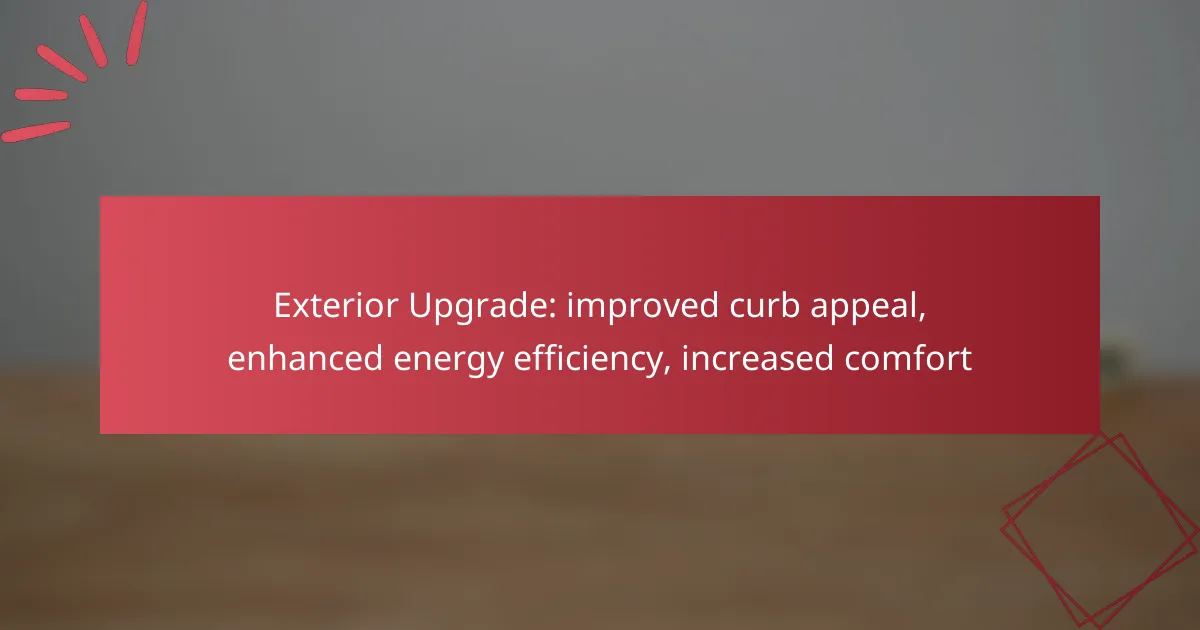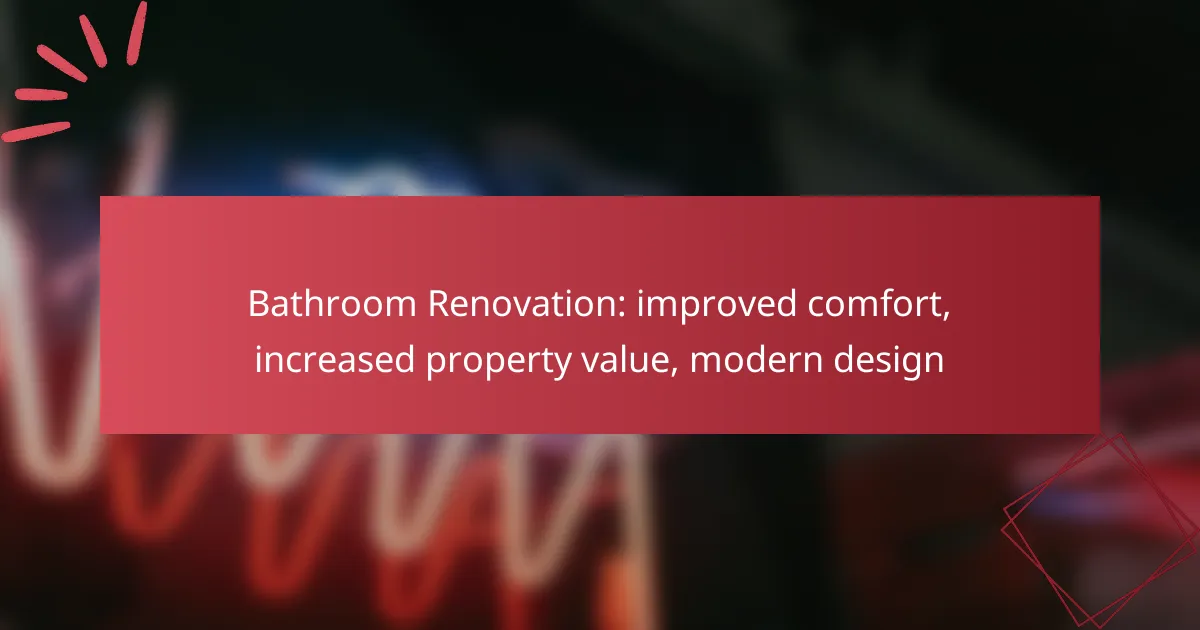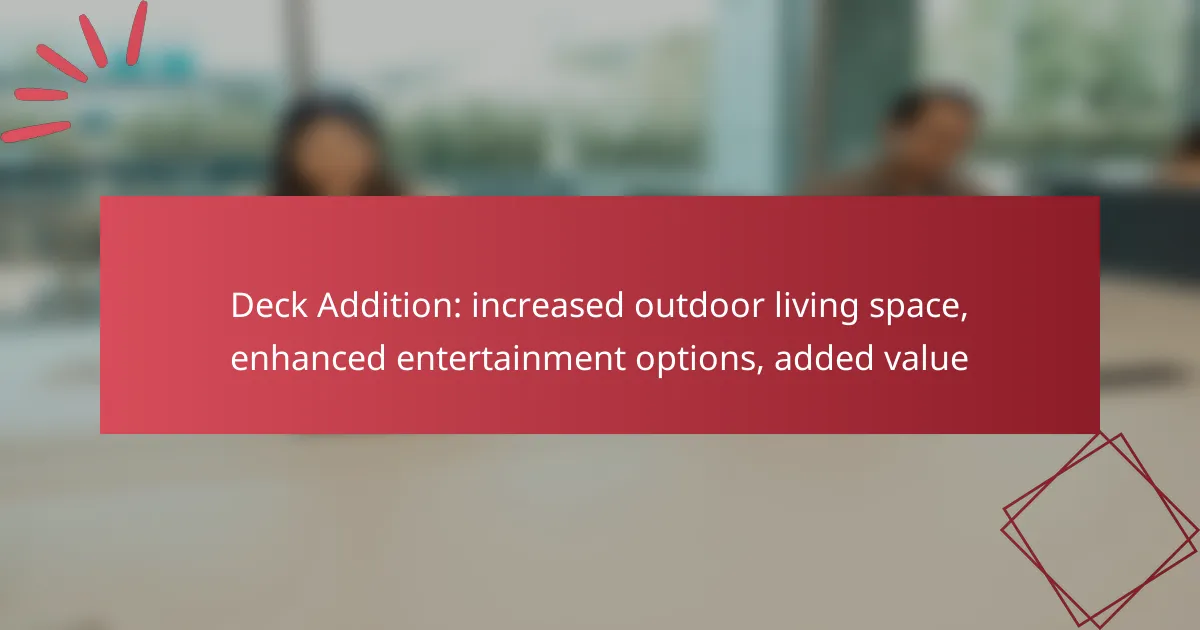Investing in exterior upgrades can transform your home by boosting its curb appeal, making it more attractive to potential buyers and enhancing its overall value. Additionally, these improvements can significantly increase energy efficiency, leading to lower utility bills and a more comfortable living environment. By incorporating features like energy-efficient windows and insulated doors, homeowners can enjoy a stable indoor climate while reducing energy consumption.

How can exterior upgrades improve curb appeal?
Exterior upgrades can significantly enhance curb appeal by making a property more visually appealing and inviting. These improvements not only attract potential buyers but also increase the overall value of the home.
New siding installation
Installing new siding can dramatically transform the look of a home. Options like vinyl, wood, or fiber cement siding offer various aesthetics and durability levels, allowing homeowners to choose based on style and maintenance preferences.
Consider the local climate when selecting siding materials. For instance, homes in areas with extreme weather may benefit from more durable options like fiber cement, which can withstand harsh conditions better than traditional wood siding.
Landscaping enhancements
Improving landscaping is one of the most effective ways to boost curb appeal. Simple changes like planting colorful flowers, adding shrubs, or maintaining a well-manicured lawn can create a welcoming atmosphere.
Incorporating native plants can reduce maintenance and water usage, making landscaping both eco-friendly and cost-effective. Additionally, consider adding mulch or decorative stones for visual interest and to suppress weeds.
Exterior painting
A fresh coat of paint can revitalize a home’s exterior and significantly enhance its curb appeal. Choose colors that complement the architectural style of the house and harmonize with the surroundings.
When painting, ensure proper surface preparation and use high-quality, weather-resistant paint to extend the life of the finish. Regular maintenance, such as touch-ups, can keep the home looking fresh and inviting.
Front door replacement
Replacing an old front door can make a strong first impression. Opt for a door that reflects your home’s style while providing security and energy efficiency.
Consider doors made from fiberglass or steel for durability and insulation. Adding decorative hardware or a fresh coat of paint can further enhance the door’s appeal, making it a focal point of the home’s exterior.
Outdoor lighting improvements
Upgrading outdoor lighting can enhance both safety and aesthetics. Well-placed lights can highlight architectural features, illuminate pathways, and create a warm ambiance.
Consider energy-efficient LED fixtures for cost savings and longevity. Motion-sensor lights can improve security while also providing convenience for homeowners and guests alike.

What exterior upgrades enhance energy efficiency?
Exterior upgrades that enhance energy efficiency include improvements that reduce energy consumption and increase comfort in your home. Key upgrades such as energy-efficient windows, insulated doors, high R-value roofing materials, and solar panel installations can significantly lower utility bills and improve overall home performance.
Energy-efficient windows
Energy-efficient windows are designed to minimize heat transfer, keeping your home warmer in winter and cooler in summer. Look for windows with double or triple glazing, low-emissivity (Low-E) coatings, and gas fills like argon or krypton for optimal performance.
When selecting windows, consider the U-factor and Solar Heat Gain Coefficient (SHGC) ratings, which indicate insulation effectiveness and solar heat absorption, respectively. Energy-efficient windows can reduce heating and cooling costs by 10-25% over traditional windows.
Insulated doors
Insulated doors help maintain indoor temperatures by reducing heat loss. Choose doors made from materials like fiberglass or steel with a high insulation value, ensuring they are well-sealed to prevent drafts.
Look for doors with an R-value of at least 5 for exterior doors. Proper installation is crucial; even the best door can underperform if not fitted correctly. Regularly check seals and weather stripping to maintain energy efficiency.
Roofing materials with high R-value
Roofing materials with high R-value provide excellent insulation, helping to keep your home comfortable year-round. Materials such as spray foam, rigid foam boards, and certain types of shingles can significantly improve your roof’s thermal performance.
When selecting roofing, consider options that meet local building codes and energy efficiency standards. A high R-value roof can reduce energy costs by 10-20%, particularly in regions with extreme temperatures.
Solar panels installation
Installing solar panels can dramatically enhance energy efficiency by generating renewable energy for your home. This reduces reliance on grid electricity, leading to lower utility bills and a smaller carbon footprint.
When considering solar panels, evaluate your roof’s orientation, shading, and local incentives. Many areas offer tax credits or rebates, which can offset installation costs. A typical residential solar system can pay for itself in 5-10 years, depending on energy usage and local electricity rates.
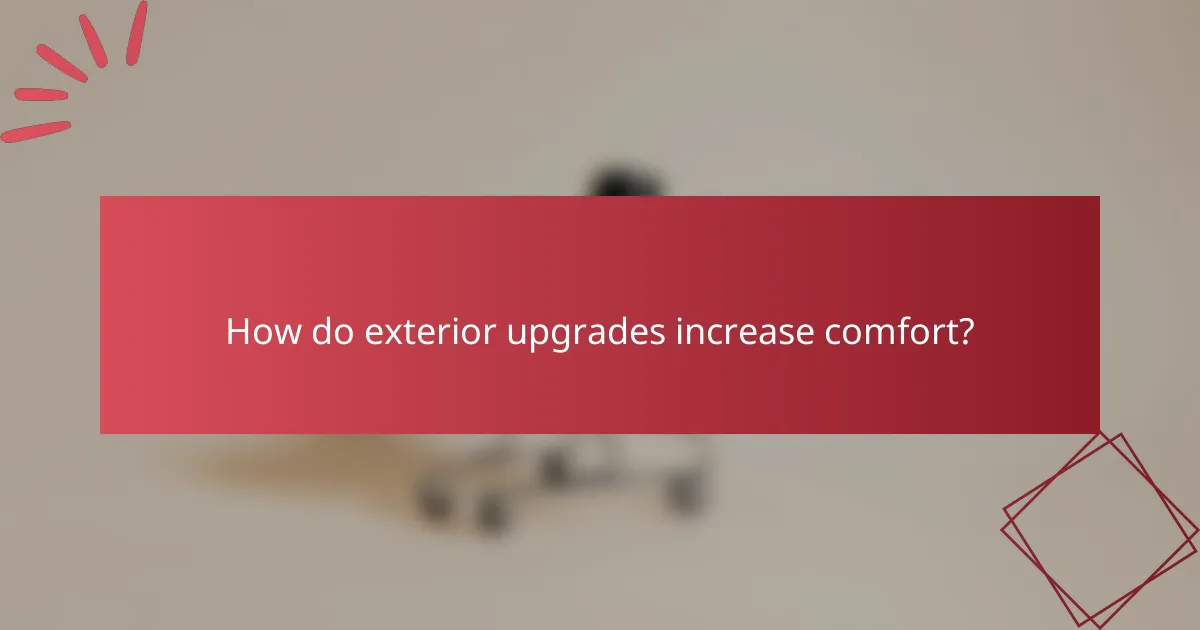
How do exterior upgrades increase comfort?
Exterior upgrades enhance comfort by improving the thermal efficiency of a home, leading to a more stable indoor climate. These upgrades can significantly reduce drafts and temperature fluctuations, making living spaces more enjoyable year-round.
Improved insulation
Upgrading insulation is crucial for maintaining a comfortable indoor environment. High-quality insulation materials, such as spray foam or rigid foam boards, can reduce heat loss in winter and keep homes cooler in summer. Consider insulating attics, walls, and basements to achieve optimal results.
When selecting insulation, aim for a high R-value, which measures thermal resistance. For most climates, an R-value between 30 and 60 is recommended for attics, while walls typically require R-values between 13 and 21.
HVAC system upgrades
Modernizing your HVAC system can significantly enhance comfort levels. Energy-efficient systems, such as those with SEER ratings above 16, provide better temperature control and lower energy bills. Regular maintenance, including filter changes and system checks, ensures optimal performance.
Consider adding smart thermostats that allow for programmable settings, enabling you to adjust temperatures based on your schedule. This can lead to increased comfort and energy savings, as the system operates only when needed.
Weatherproofing techniques
Weatherproofing is essential for preventing drafts and moisture intrusion, which can disrupt comfort. Techniques include sealing gaps around windows and doors with caulk or weatherstripping, and ensuring that your roof and siding are in good condition to prevent leaks.
Regular inspections can help identify areas needing attention. Pay special attention to common problem areas such as around plumbing fixtures and electrical outlets, where air leaks often occur. Implementing these techniques can lead to a more consistent indoor climate and improved energy efficiency.
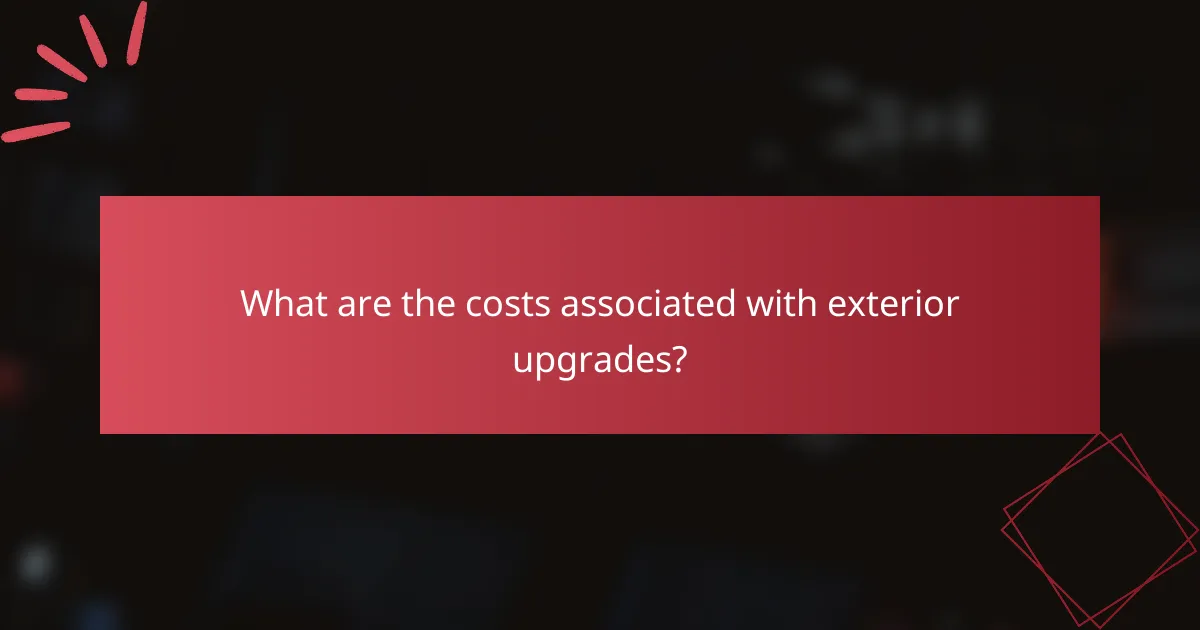
What are the costs associated with exterior upgrades?
The costs of exterior upgrades can vary significantly based on the type of improvement, materials used, and local labor rates. Homeowners should budget for these enhancements by considering both immediate expenses and potential long-term savings in energy efficiency and maintenance.
Average costs for siding replacement
Siding replacement typically ranges from $3,000 to $15,000, depending on the material chosen and the size of the home. Vinyl siding is often the most affordable option, while wood or fiber cement can increase costs significantly.
When planning for siding replacement, consider additional expenses such as removal of old siding, insulation upgrades, and any necessary repairs to the underlying structure. Always obtain multiple quotes from contractors to ensure competitive pricing.
Landscaping budget estimates
Landscaping costs can vary widely, with basic projects starting around $1,500 and more elaborate designs reaching $10,000 or more. Factors influencing the budget include plant selection, hardscaping features, and the complexity of the design.
To maximize curb appeal without overspending, focus on low-maintenance plants and consider DIY options for smaller projects. A well-planned landscape can enhance property value and reduce water usage with native plants.
Energy-efficient window pricing
Upgrading to energy-efficient windows generally costs between $300 and $1,000 per window, depending on the type and installation complexity. Double or triple-pane windows with low-E coatings tend to offer the best energy savings.
When selecting windows, look for those with Energy Star certification to ensure compliance with energy efficiency standards. Consider the long-term savings on heating and cooling bills, which can offset the initial investment over time.
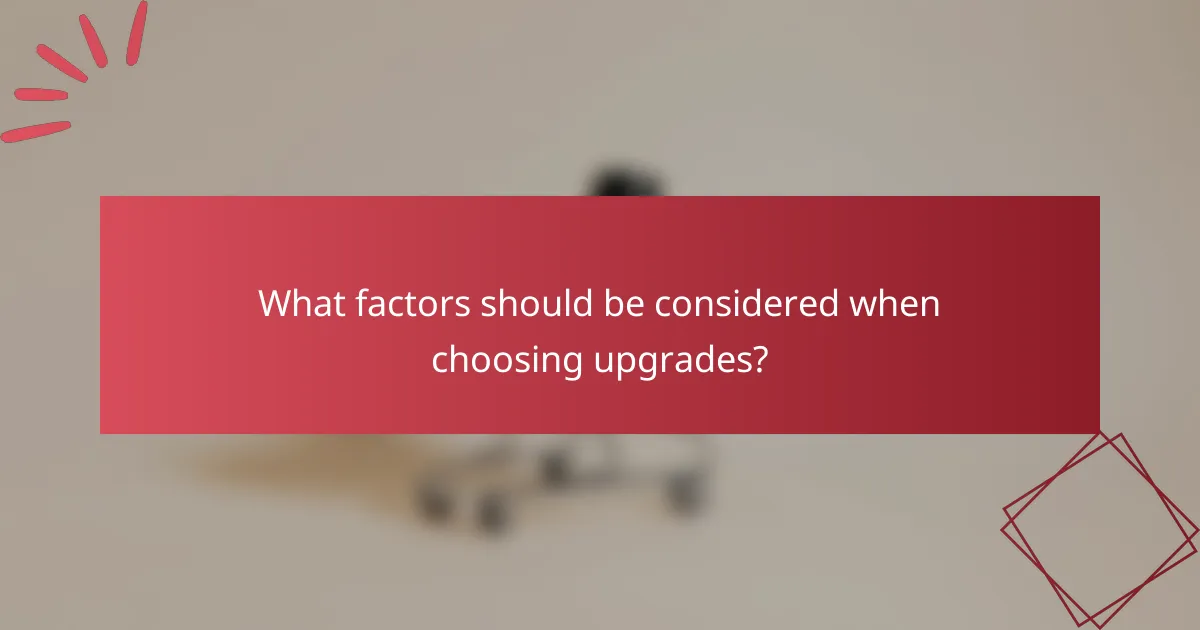
What factors should be considered when choosing upgrades?
When selecting upgrades for improved curb appeal, enhanced energy efficiency, and increased comfort, consider local climate, homeowner association regulations, and potential return on investment. Each of these factors plays a crucial role in ensuring that your upgrades are effective, compliant, and financially sound.
Local climate impact
The local climate significantly influences the types of upgrades that will be most beneficial. For instance, homes in colder regions may require better insulation and energy-efficient windows, while those in warmer areas might prioritize shading and ventilation solutions. Understanding your climate can help you choose materials and designs that enhance comfort and reduce energy costs.
Consider the average temperature ranges and precipitation patterns in your area. For example, homes in humid climates may benefit from moisture-resistant materials, while those in dry areas might need features that prevent heat absorption. Tailoring your upgrades to local conditions can lead to better performance and longevity.
Homeowner association regulations
Homeowner associations (HOAs) often have specific guidelines regarding exterior upgrades that must be adhered to. Before making any changes, review your HOA’s rules to ensure compliance with aesthetic standards and material choices. Violating these regulations can result in fines or required removal of non-compliant upgrades.
Common HOA regulations may include restrictions on color schemes, types of landscaping, and the installation of fences or decks. Engaging with your HOA early in the planning process can help you avoid costly mistakes and ensure that your upgrades enhance both your home and the neighborhood.
Return on investment analysis
Evaluating the return on investment (ROI) for upgrades is essential to ensure that your expenditures yield financial benefits. Some upgrades, such as energy-efficient windows or high-quality siding, can significantly increase a home’s value and reduce energy bills, making them wise investments.
To analyze ROI, consider both the upfront costs and the long-term savings. Research local market trends to determine which upgrades are most appealing to potential buyers. Tools like cost vs. value reports can provide insights into which renovations typically yield the highest returns in your area.
